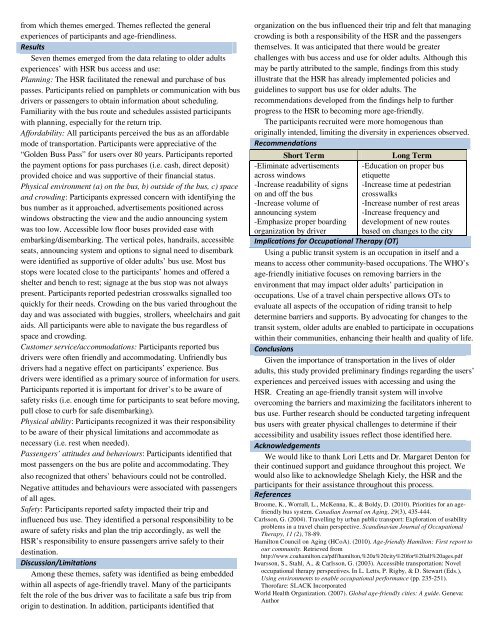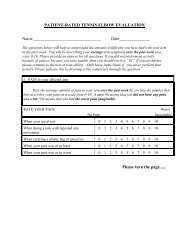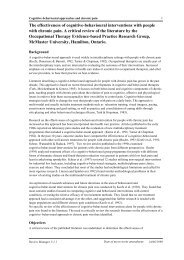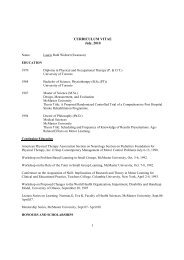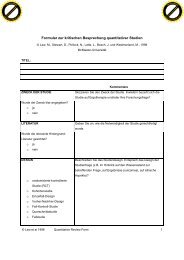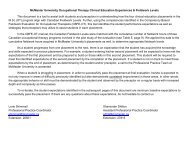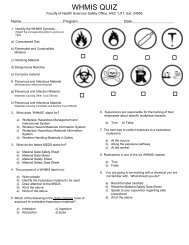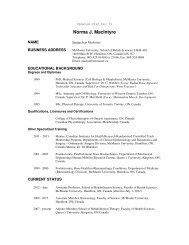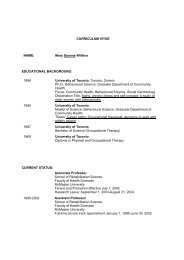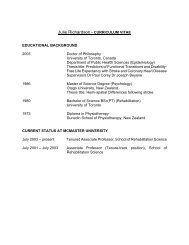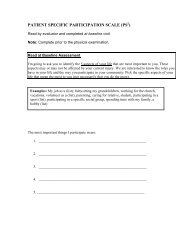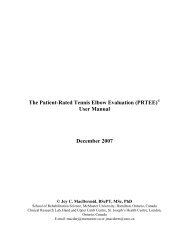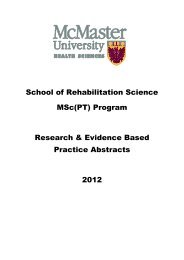Evidence Based Practice Symposium - McMaster University
Evidence Based Practice Symposium - McMaster University
Evidence Based Practice Symposium - McMaster University
You also want an ePaper? Increase the reach of your titles
YUMPU automatically turns print PDFs into web optimized ePapers that Google loves.
from which themes emerged. Themes reflected the general<br />
experiences of participants and age-friendliness.<br />
Results<br />
Seven themes emerged from the data relating to older adults<br />
experiences’ with HSR bus access and use:<br />
Planning: The HSR facilitated the renewal and purchase of bus<br />
passes. Participants relied on pamphlets or communication with bus<br />
drivers or passengers to obtain information about scheduling.<br />
Familiarity with the bus route and schedules assisted participants<br />
with planning, especially for the return trip.<br />
Affordability: All participants perceived the bus as an affordable<br />
mode of transportation. Participants were appreciative of the<br />
“Golden Buss Pass” for users over 80 years. Participants reported<br />
the payment options for pass purchases (i.e. cash, direct deposit)<br />
provided choice and was supportive of their financial status.<br />
Physical environment (a) on the bus, b) outside of the bus, c) space<br />
and crowding: Participants expressed concern with identifying the<br />
bus number as it approached, advertisements positioned across<br />
windows obstructing the view and the audio announcing system<br />
was too low. Accessible low floor buses provided ease with<br />
embarking/disembarking. The vertical poles, handrails, accessible<br />
seats, announcing system and options to signal need to disembark<br />
were identified as supportive of older adults’ bus use. Most bus<br />
stops were located close to the participants’ homes and offered a<br />
shelter and bench to rest; signage at the bus stop was not always<br />
present. Participants reported pedestrian crosswalks signalled too<br />
quickly for their needs. Crowding on the bus varied throughout the<br />
day and was associated with buggies, strollers, wheelchairs and gait<br />
aids. All participants were able to navigate the bus regardless of<br />
space and crowding.<br />
Customer service/accommodations: Participants reported bus<br />
drivers were often friendly and accommodating. Unfriendly bus<br />
drivers had a negative effect on participants’ experience. Bus<br />
drivers were identified as a primary source of information for users.<br />
Participants reported it is important for driver’s to be aware of<br />
safety risks (i.e. enough time for participants to seat before moving,<br />
pull close to curb for safe disembarking).<br />
Physical ability: Participants recognized it was their responsibility<br />
to be aware of their physical limitations and accommodate as<br />
necessary (i.e. rest when needed).<br />
Passengers’ attitudes and behaviours: Participants identified that<br />
most passengers on the bus are polite and accommodating. They<br />
also recognized that others’ behaviours could not be controlled.<br />
Negative attitudes and behaviours were associated with passengers<br />
of all ages.<br />
Safety: Participants reported safety impacted their trip and<br />
influenced bus use. They identified a personal responsibility to be<br />
aware of safety risks and plan the trip accordingly, as well the<br />
HSR’s responsibility to ensure passengers arrive safely to their<br />
destination.<br />
Discussion/Limitations<br />
Among these themes, safety was identified as being embedded<br />
within all aspects of age-friendly travel. Many of the participants<br />
felt the role of the bus driver was to facilitate a safe bus trip from<br />
origin to destination. In addition, participants identified that<br />
organization on the bus influenced their trip and felt that managing<br />
crowding is both a responsibility of the HSR and the passengers<br />
themselves. It was anticipated that there would be greater<br />
challenges with bus access and use for older adults. Although this<br />
may be partly attributed to the sample, findings from this study<br />
illustrate that the HSR has already implemented policies and<br />
guidelines to support bus use for older adults. The<br />
recommendations developed from the findings help to further<br />
progress to the HSR to becoming more age-friendly.<br />
The participants recruited were more homogenous than<br />
originally intended, limiting the diversity in experiences observed.<br />
Recommendations<br />
Short Term Long Term<br />
-Eliminate advertisements<br />
across windows<br />
-Increase readability of signs<br />
on and off the bus<br />
-Increase volume of<br />
announcing system<br />
-Emphasize proper boarding<br />
organization by driver<br />
-Education on proper bus<br />
etiquette<br />
-Increase time at pedestrian<br />
crosswalks<br />
-Increase number of rest areas<br />
-Increase frequency and<br />
development of new routes<br />
based on changes to the city<br />
Implications for Occupational Therapy (OT)<br />
Using a public transit system is an occupation in itself and a<br />
means to access other community-based occupations. The WHO’s<br />
age-friendly initiative focuses on removing barriers in the<br />
environment that may impact older adults’ participation in<br />
occupations. Use of a travel chain perspective allows OTs to<br />
evaluate all aspects of the occupation of riding transit to help<br />
determine barriers and supports. By advocating for changes to the<br />
transit system, older adults are enabled to participate in occupations<br />
within their communities, enhancing their health and quality of life.<br />
Conclusions<br />
Given the importance of transportation in the lives of older<br />
adults, this study provided preliminary findings regarding the users’<br />
experiences and perceived issues with accessing and using the<br />
HSR. Creating an age-friendly transit system will involve<br />
overcoming the barriers and maximizing the facilitators inherent to<br />
bus use. Further research should be conducted targeting infrequent<br />
bus users with greater physical challenges to determine if their<br />
accessibility and usability issues reflect those identified here.<br />
Acknowledgements<br />
We would like to thank Lori Letts and Dr. Margaret Denton for<br />
their continued support and guidance throughout this project. We<br />
would also like to acknowledge Shelagh Kiely, the HSR and the<br />
participants for their assistance throughout this process.<br />
References<br />
Broome, K., Worrall, L., McKenna, K., & Boldy, D. (2010). Priorities for an agefriendly<br />
bus system. Canadian Journal on Aging, 29(3), 435-444.<br />
Carlsson, G. (2004). Travelling by urban public transport: Exploration of usability<br />
problems in a travel chain perspective. Scandinavian Journal of Occupational<br />
Therapy, 11 (2), 78-89.<br />
Hamilton Council on Aging (HCoA). (2010). Age-friendly Hamilton: First report to<br />
our community. Retrieved from<br />
http://www.coahamilton.ca/pdf/hamilton,%20a%20city%20for%20all%20ages.pdf<br />
Iwarsson, S., Stahl, A., & Carlsson, G. (2003). Accessible transportation: Novel<br />
occupational therapy perspectives. In L. Letts, P. Rigby, & D. Stewart (Eds.),<br />
Using environments to enable occupational performance (pp. 235-251).<br />
Thorofare: SLACK Incorporated<br />
World Health Organization. (2007). Global age-friendly cities: A guide. Geneva:<br />
Author


